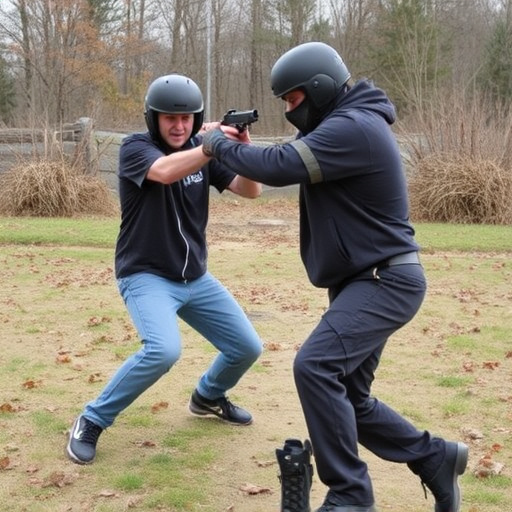For college students considering self-defense stun guns, voltage range (50,000-120,000 volts) is key for effectiveness and safety. Devices should have critical features like durable construction, easy activation, and targeting vulnerable areas. Prioritize compact design, portability, and waterproof models with added lights. Training is essential to learn correct application techniques, de-escalation, and maintain proficiency through regular refreshers. Follow legal guidelines and store stun guns securely away from children and unauthorized individuals.
“Equipped with knowledge is a powerful tool for self-defense, especially for college students navigating unfamiliar territories. This article delves into the world of stun guns, providing a comprehensive guide for self-defense strategies. We explore the critical concept of stun gun voltage and its impact on safety, empowering students to make informed choices.
From understanding voltage ranges to selecting the right device, we cover essential aspects. Learn about safety specifications, best practices, and training methods to ensure responsible and effective use in potential self-defense scenarios.”
- Understanding Stun Gun Voltage: What It Means for College Students
- Safety Specifications: A Comprehensive Look at Stun Guns for Self-Defense
- Choosing the Right Stun Gun: Factors to Consider for Effective Self-Protection on Campus
- Best Practices and Training: Ensuring Safe Use of Stun Guns in Self-Defense Scenarios
Understanding Stun Gun Voltage: What It Means for College Students
Stun gun voltage is a critical specification that college students should understand when considering self-defense options. These devices operate by delivering an electric shock, and the voltage range determines its effectiveness and safety. Typically, stun guns for personal protection have voltages ranging from 50,000 to 120,000 volts. This high voltage is designed to incapacitate an attacker temporarily, providing users with precious time to escape potentially dangerous situations.
For college students, self-defense stun guns can be valuable tools, especially considering the increased awareness of personal safety on campus. Understanding voltage allows users to make informed decisions about which stun gun best suits their needs and ensures they are equipped with a reliable device that meets industry standards for safety. Knowing the voltage range helps in choosing a stun gun that delivers enough power to deter an assailant while adhering to legal guidelines.
Safety Specifications: A Comprehensive Look at Stun Guns for Self-Defense
Self-defense stun guns, especially those designed for college students, come with a range of safety specifications that are crucial to understand before use. These devices typically operate on a voltage range, usually between 50,000 to 150,000 volts. Such high voltage is intended to temporarily incapacitate an aggressor without causing permanent harm or serious injury. It’s important to note that stun guns are not weapons of mass destruction; their effectiveness relies on proper usage and targeting specific vulnerable areas like the legs, arms, or neck.
Safety features also encompass the design and build quality of the device. Look for models with durable yet lightweight construction, easy-to-grasp handles, and intuitive activation mechanisms. Some stun guns are equipped with LED lights or loud alarms that can startle an attacker while drawing attention to the user’s location, potentially deterring further aggression. For college students, a compact, portable stun gun that fits easily in a backpack or pocket is ideal, ensuring accessibility during emergencies. Always follow safety guidelines and store stun guns away from children and unauthorized individuals.
Choosing the Right Stun Gun: Factors to Consider for Effective Self-Protection on Campus
When selecting a self-defense stun gun, especially for college students looking to enhance their personal safety on campus, several key factors come into play. The primary consideration is the voltage range – a crucial aspect that determines the stun gun’s effectiveness. Stun guns are designed to deliver an electric shock, temporarily incapacitating the target, and the voltage plays a vital role in achieving this. For self-defense purposes, look for stun guns with a voltage range between 4 million and 12 million volts. This range ensures sufficient power to deter potential assailants while minimizing the risk of severe injury or permanent damage, which can be a legal concern.
Additionally, consider the stun gun’s build quality, ease of use, and features like LED lights or a compact design for convenience. Waterproof models are also advantageous, as they offer protection from accidental damage and allow for outdoor use. Students should opt for stun guns that are easily accessible and discreet, such as those designed to look like everyday objects, ensuring users can respond swiftly in case of an emergency without drawing unnecessary attention.
Best Practices and Training: Ensuring Safe Use of Stun Guns in Self-Defense Scenarios
When it comes to self-defense scenarios, especially for college students carrying stun guns, proper training and adherence to best practices are paramount. Beyond understanding the legal implications and range safety specs, users must be educated on safe handling procedures. This includes learning the correct application techniques—how to aim, activate, and follow up after deployment. Training should also cover de-escalation tactics, as stun guns are meant to incapacitate temporarily, not harm permanently. It’s crucial to practice in simulated scenarios, understanding the weapon’s range limitations and its effect on various targets to ensure safe and effective use.
Regular refreshers and advanced training sessions can help maintain proficiency, especially given that self-defense strategies and stun gun technology evolve over time. For college students considering self-defense as a last resort, these practices not only enhance safety but also build confidence. Proper education empowers users to make informed decisions, understanding the device’s capabilities and limitations, thereby promoting responsible use in potentially dangerous situations.
When it comes to self-defense for college students, stun guns equipped with the right voltage range and safety specs can be a valuable tool. Understanding the concept of voltage and its impact is key to making an informed choice. By considering factors like power, safety features, and proper training, students can effectively protect themselves in various scenarios. With the right knowledge and responsible handling, self-defense stun guns have the potential to revolutionize campus safety, empowering students to take control and enhance their personal security.
